Leadership and Management: A Toyota Case Study Report
VerifiedAdded on 2021/01/02
|17
|5915
|345
Report
AI Summary
This report provides a comprehensive analysis of leadership and management practices within Toyota, a multinational automotive manufacturing company. The report begins by comparing the roles and characteristics of leaders and managers, highlighting their responsibilities in setting visions, allocating resources, and delegating tasks. It then delves into the application of various management and leadership theories, including scientific management, systems management, contingency theory, and situational leadership, illustrating how these theories are applied in different operational scenarios within Toyota. The report further examines the strengths and weaknesses of different leadership approaches and explores the key roles of managers and leaders in critical operational functions. It also discusses the factors impacting operational management and emphasizes the significance of operations management in achieving business objectives. The report concludes with a summary of the key findings and insights into the effective management and leadership strategies at Toyota.
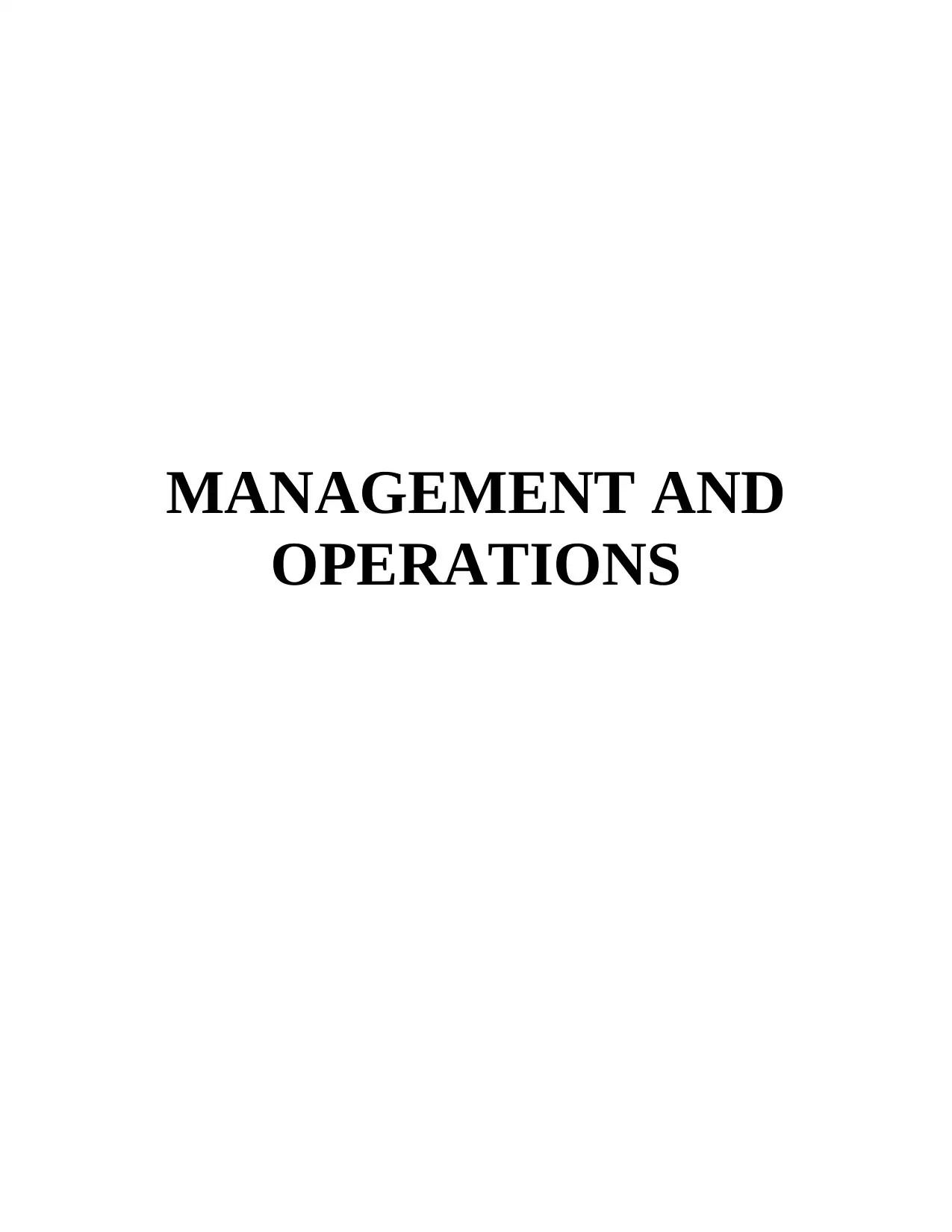
MANAGEMENT AND
OPERATIONS
OPERATIONS
Paraphrase This Document
Need a fresh take? Get an instant paraphrase of this document with our AI Paraphraser
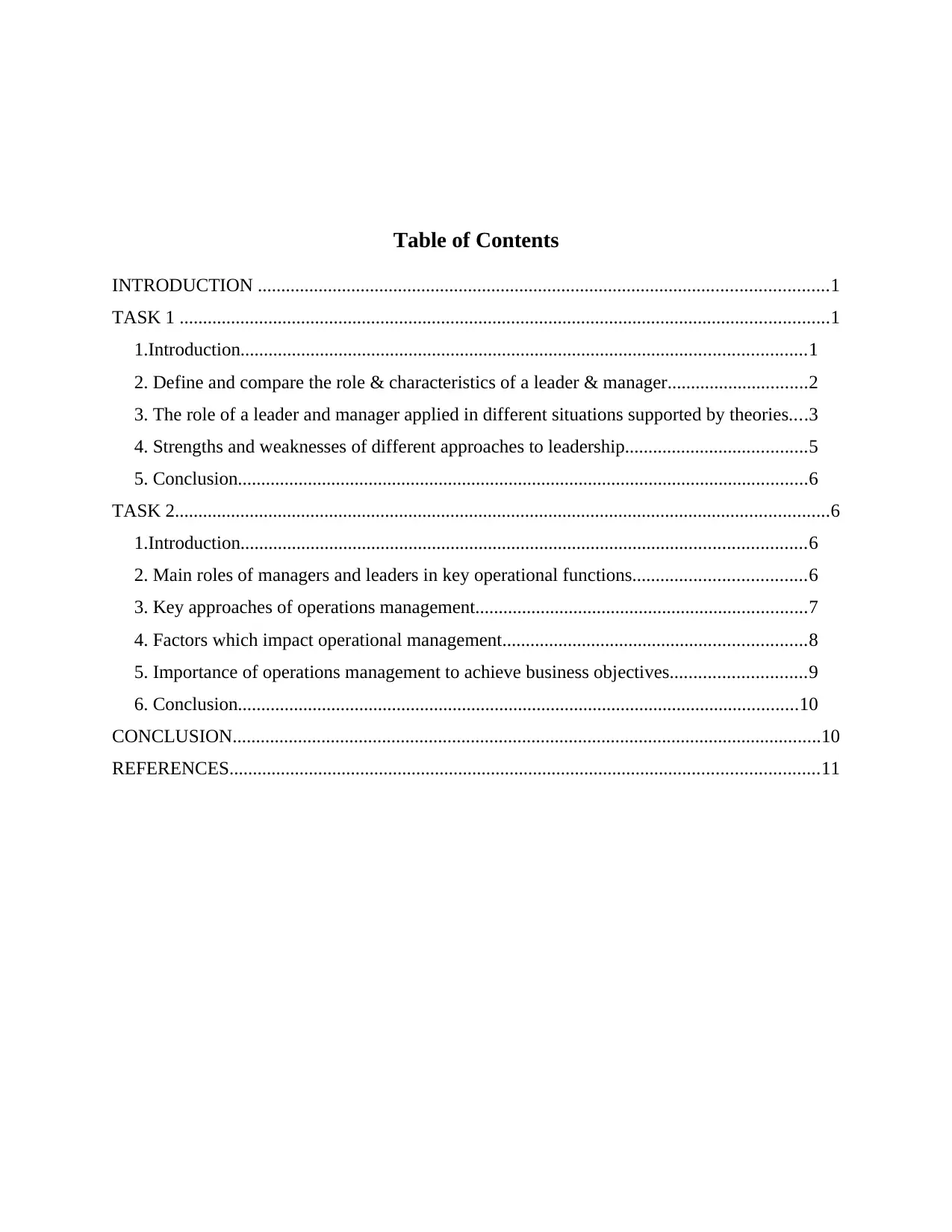
Table of Contents
INTRODUCTION ..........................................................................................................................1
TASK 1 ...........................................................................................................................................1
1.Introduction.........................................................................................................................1
2. Define and compare the role & characteristics of a leader & manager..............................2
3. The role of a leader and manager applied in different situations supported by theories....3
4. Strengths and weaknesses of different approaches to leadership.......................................5
5. Conclusion..........................................................................................................................6
TASK 2............................................................................................................................................6
1.Introduction.........................................................................................................................6
2. Main roles of managers and leaders in key operational functions.....................................6
3. Key approaches of operations management.......................................................................7
4. Factors which impact operational management.................................................................8
5. Importance of operations management to achieve business objectives.............................9
6. Conclusion........................................................................................................................10
CONCLUSION..............................................................................................................................10
REFERENCES..............................................................................................................................11
INTRODUCTION ..........................................................................................................................1
TASK 1 ...........................................................................................................................................1
1.Introduction.........................................................................................................................1
2. Define and compare the role & characteristics of a leader & manager..............................2
3. The role of a leader and manager applied in different situations supported by theories....3
4. Strengths and weaknesses of different approaches to leadership.......................................5
5. Conclusion..........................................................................................................................6
TASK 2............................................................................................................................................6
1.Introduction.........................................................................................................................6
2. Main roles of managers and leaders in key operational functions.....................................6
3. Key approaches of operations management.......................................................................7
4. Factors which impact operational management.................................................................8
5. Importance of operations management to achieve business objectives.............................9
6. Conclusion........................................................................................................................10
CONCLUSION..............................................................................................................................10
REFERENCES..............................................................................................................................11
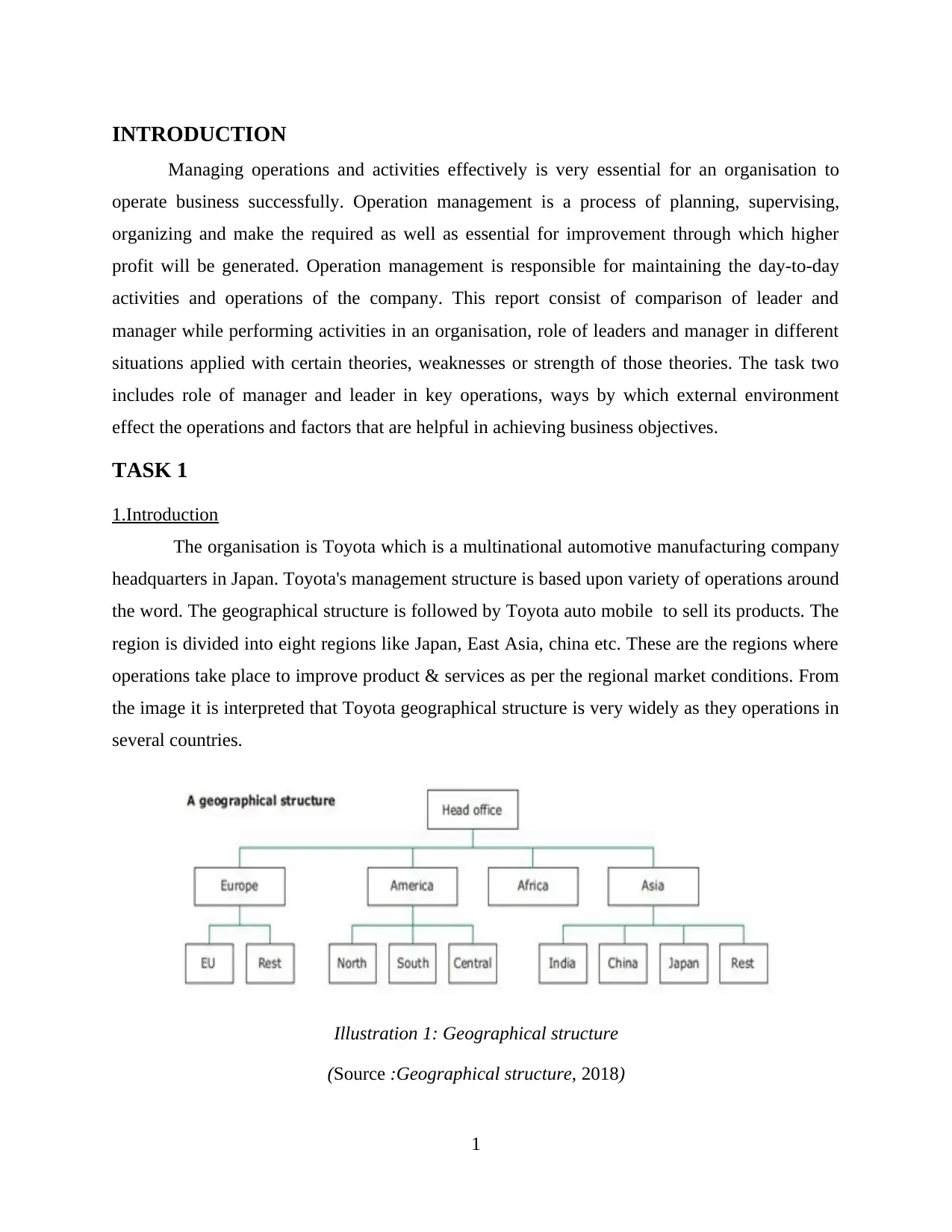
INTRODUCTION
Managing operations and activities effectively is very essential for an organisation to
operate business successfully. Operation management is a process of planning, supervising,
organizing and make the required as well as essential for improvement through which higher
profit will be generated. Operation management is responsible for maintaining the day-to-day
activities and operations of the company. This report consist of comparison of leader and
manager while performing activities in an organisation, role of leaders and manager in different
situations applied with certain theories, weaknesses or strength of those theories. The task two
includes role of manager and leader in key operations, ways by which external environment
effect the operations and factors that are helpful in achieving business objectives.
TASK 1
1.Introduction
The organisation is Toyota which is a multinational automotive manufacturing company
headquarters in Japan. Toyota's management structure is based upon variety of operations around
the word. The geographical structure is followed by Toyota auto mobile to sell its products. The
region is divided into eight regions like Japan, East Asia, china etc. These are the regions where
operations take place to improve product & services as per the regional market conditions. From
the image it is interpreted that Toyota geographical structure is very widely as they operations in
several countries.
(Source :Geographical structure, 2018)
1
Illustration 1: Geographical structure
Managing operations and activities effectively is very essential for an organisation to
operate business successfully. Operation management is a process of planning, supervising,
organizing and make the required as well as essential for improvement through which higher
profit will be generated. Operation management is responsible for maintaining the day-to-day
activities and operations of the company. This report consist of comparison of leader and
manager while performing activities in an organisation, role of leaders and manager in different
situations applied with certain theories, weaknesses or strength of those theories. The task two
includes role of manager and leader in key operations, ways by which external environment
effect the operations and factors that are helpful in achieving business objectives.
TASK 1
1.Introduction
The organisation is Toyota which is a multinational automotive manufacturing company
headquarters in Japan. Toyota's management structure is based upon variety of operations around
the word. The geographical structure is followed by Toyota auto mobile to sell its products. The
region is divided into eight regions like Japan, East Asia, china etc. These are the regions where
operations take place to improve product & services as per the regional market conditions. From
the image it is interpreted that Toyota geographical structure is very widely as they operations in
several countries.
(Source :Geographical structure, 2018)
1
Illustration 1: Geographical structure
⊘ This is a preview!⊘
Do you want full access?
Subscribe today to unlock all pages.

Trusted by 1+ million students worldwide
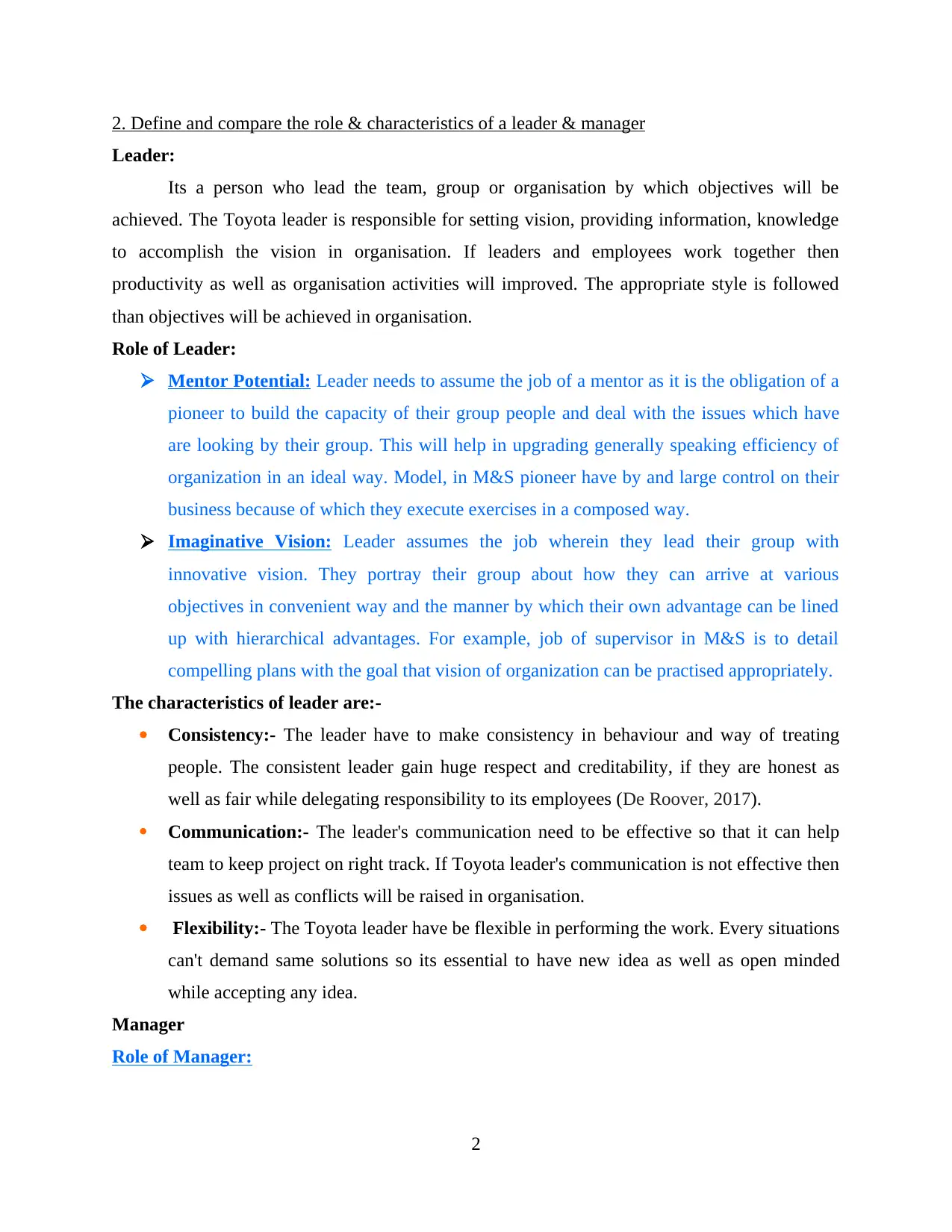
2. Define and compare the role & characteristics of a leader & manager
Leader:
Its a person who lead the team, group or organisation by which objectives will be
achieved. The Toyota leader is responsible for setting vision, providing information, knowledge
to accomplish the vision in organisation. If leaders and employees work together then
productivity as well as organisation activities will improved. The appropriate style is followed
than objectives will be achieved in organisation.
Role of Leader:
Mentor Potential: Leader needs to assume the job of a mentor as it is the obligation of a
pioneer to build the capacity of their group people and deal with the issues which have
are looking by their group. This will help in upgrading generally speaking efficiency of
organization in an ideal way. Model, in M&S pioneer have by and large control on their
business because of which they execute exercises in a composed way.
Imaginative Vision: Leader assumes the job wherein they lead their group with
innovative vision. They portray their group about how they can arrive at various
objectives in convenient way and the manner by which their own advantage can be lined
up with hierarchical advantages. For example, job of supervisor in M&S is to detail
compelling plans with the goal that vision of organization can be practised appropriately.
The characteristics of leader are:-
Consistency:- The leader have to make consistency in behaviour and way of treating
people. The consistent leader gain huge respect and creditability, if they are honest as
well as fair while delegating responsibility to its employees (De Roover, 2017).
Communication:- The leader's communication need to be effective so that it can help
team to keep project on right track. If Toyota leader's communication is not effective then
issues as well as conflicts will be raised in organisation.
Flexibility:- The Toyota leader have be flexible in performing the work. Every situations
can't demand same solutions so its essential to have new idea as well as open minded
while accepting any idea.
Manager
Role of Manager:
2
Leader:
Its a person who lead the team, group or organisation by which objectives will be
achieved. The Toyota leader is responsible for setting vision, providing information, knowledge
to accomplish the vision in organisation. If leaders and employees work together then
productivity as well as organisation activities will improved. The appropriate style is followed
than objectives will be achieved in organisation.
Role of Leader:
Mentor Potential: Leader needs to assume the job of a mentor as it is the obligation of a
pioneer to build the capacity of their group people and deal with the issues which have
are looking by their group. This will help in upgrading generally speaking efficiency of
organization in an ideal way. Model, in M&S pioneer have by and large control on their
business because of which they execute exercises in a composed way.
Imaginative Vision: Leader assumes the job wherein they lead their group with
innovative vision. They portray their group about how they can arrive at various
objectives in convenient way and the manner by which their own advantage can be lined
up with hierarchical advantages. For example, job of supervisor in M&S is to detail
compelling plans with the goal that vision of organization can be practised appropriately.
The characteristics of leader are:-
Consistency:- The leader have to make consistency in behaviour and way of treating
people. The consistent leader gain huge respect and creditability, if they are honest as
well as fair while delegating responsibility to its employees (De Roover, 2017).
Communication:- The leader's communication need to be effective so that it can help
team to keep project on right track. If Toyota leader's communication is not effective then
issues as well as conflicts will be raised in organisation.
Flexibility:- The Toyota leader have be flexible in performing the work. Every situations
can't demand same solutions so its essential to have new idea as well as open minded
while accepting any idea.
Manager
Role of Manager:
2
Paraphrase This Document
Need a fresh take? Get an instant paraphrase of this document with our AI Paraphraser
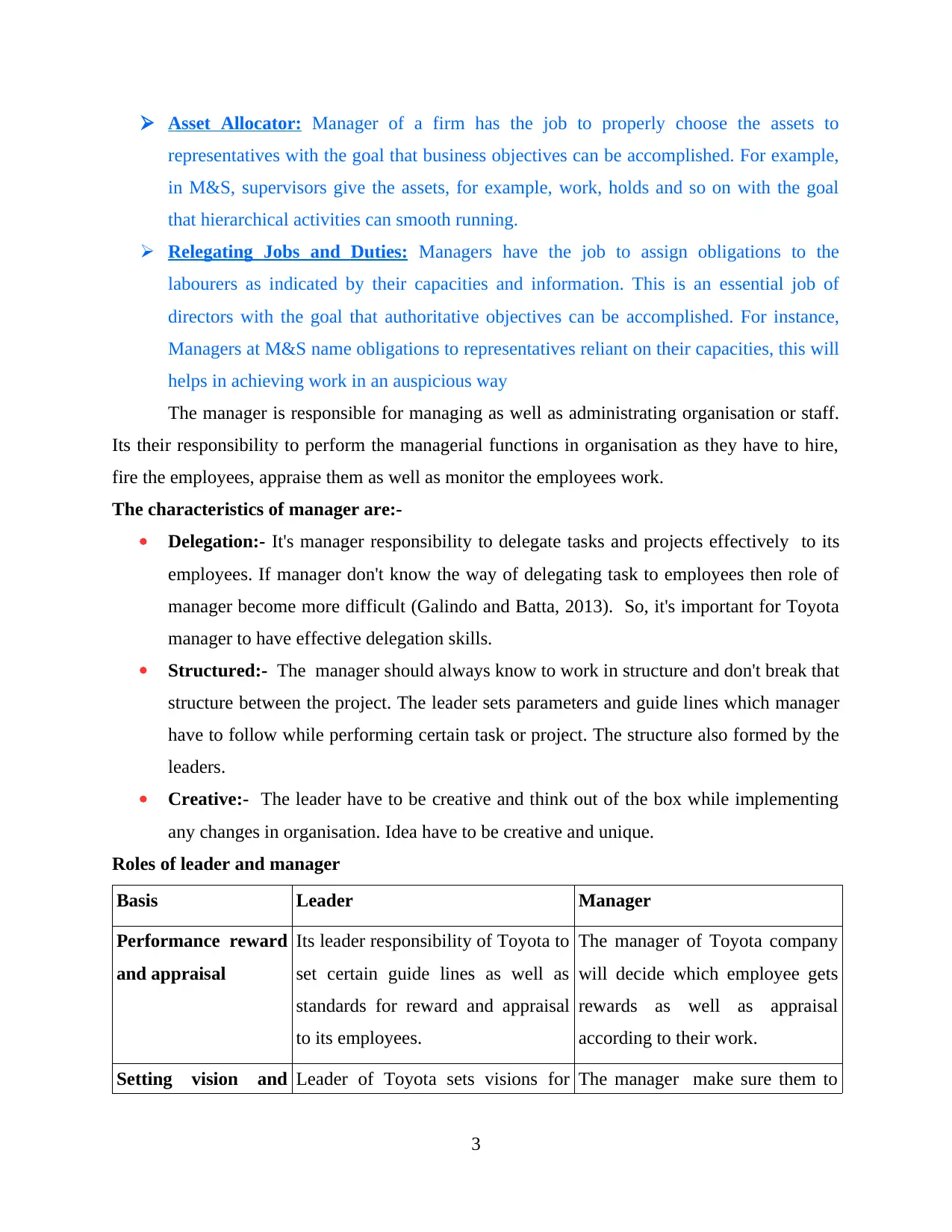
Asset Allocator: Manager of a firm has the job to properly choose the assets to
representatives with the goal that business objectives can be accomplished. For example,
in M&S, supervisors give the assets, for example, work, holds and so on with the goal
that hierarchical activities can smooth running.
Relegating Jobs and Duties: Managers have the job to assign obligations to the
labourers as indicated by their capacities and information. This is an essential job of
directors with the goal that authoritative objectives can be accomplished. For instance,
Managers at M&S name obligations to representatives reliant on their capacities, this will
helps in achieving work in an auspicious way
The manager is responsible for managing as well as administrating organisation or staff.
Its their responsibility to perform the managerial functions in organisation as they have to hire,
fire the employees, appraise them as well as monitor the employees work.
The characteristics of manager are:-
Delegation:- It's manager responsibility to delegate tasks and projects effectively to its
employees. If manager don't know the way of delegating task to employees then role of
manager become more difficult (Galindo and Batta, 2013). So, it's important for Toyota
manager to have effective delegation skills.
Structured:- The manager should always know to work in structure and don't break that
structure between the project. The leader sets parameters and guide lines which manager
have to follow while performing certain task or project. The structure also formed by the
leaders.
Creative:- The leader have to be creative and think out of the box while implementing
any changes in organisation. Idea have to be creative and unique.
Roles of leader and manager
Basis Leader Manager
Performance reward
and appraisal
Its leader responsibility of Toyota to
set certain guide lines as well as
standards for reward and appraisal
to its employees.
The manager of Toyota company
will decide which employee gets
rewards as well as appraisal
according to their work.
Setting vision and Leader of Toyota sets visions for The manager make sure them to
3
representatives with the goal that business objectives can be accomplished. For example,
in M&S, supervisors give the assets, for example, work, holds and so on with the goal
that hierarchical activities can smooth running.
Relegating Jobs and Duties: Managers have the job to assign obligations to the
labourers as indicated by their capacities and information. This is an essential job of
directors with the goal that authoritative objectives can be accomplished. For instance,
Managers at M&S name obligations to representatives reliant on their capacities, this will
helps in achieving work in an auspicious way
The manager is responsible for managing as well as administrating organisation or staff.
Its their responsibility to perform the managerial functions in organisation as they have to hire,
fire the employees, appraise them as well as monitor the employees work.
The characteristics of manager are:-
Delegation:- It's manager responsibility to delegate tasks and projects effectively to its
employees. If manager don't know the way of delegating task to employees then role of
manager become more difficult (Galindo and Batta, 2013). So, it's important for Toyota
manager to have effective delegation skills.
Structured:- The manager should always know to work in structure and don't break that
structure between the project. The leader sets parameters and guide lines which manager
have to follow while performing certain task or project. The structure also formed by the
leaders.
Creative:- The leader have to be creative and think out of the box while implementing
any changes in organisation. Idea have to be creative and unique.
Roles of leader and manager
Basis Leader Manager
Performance reward
and appraisal
Its leader responsibility of Toyota to
set certain guide lines as well as
standards for reward and appraisal
to its employees.
The manager of Toyota company
will decide which employee gets
rewards as well as appraisal
according to their work.
Setting vision and Leader of Toyota sets visions for The manager make sure them to
3
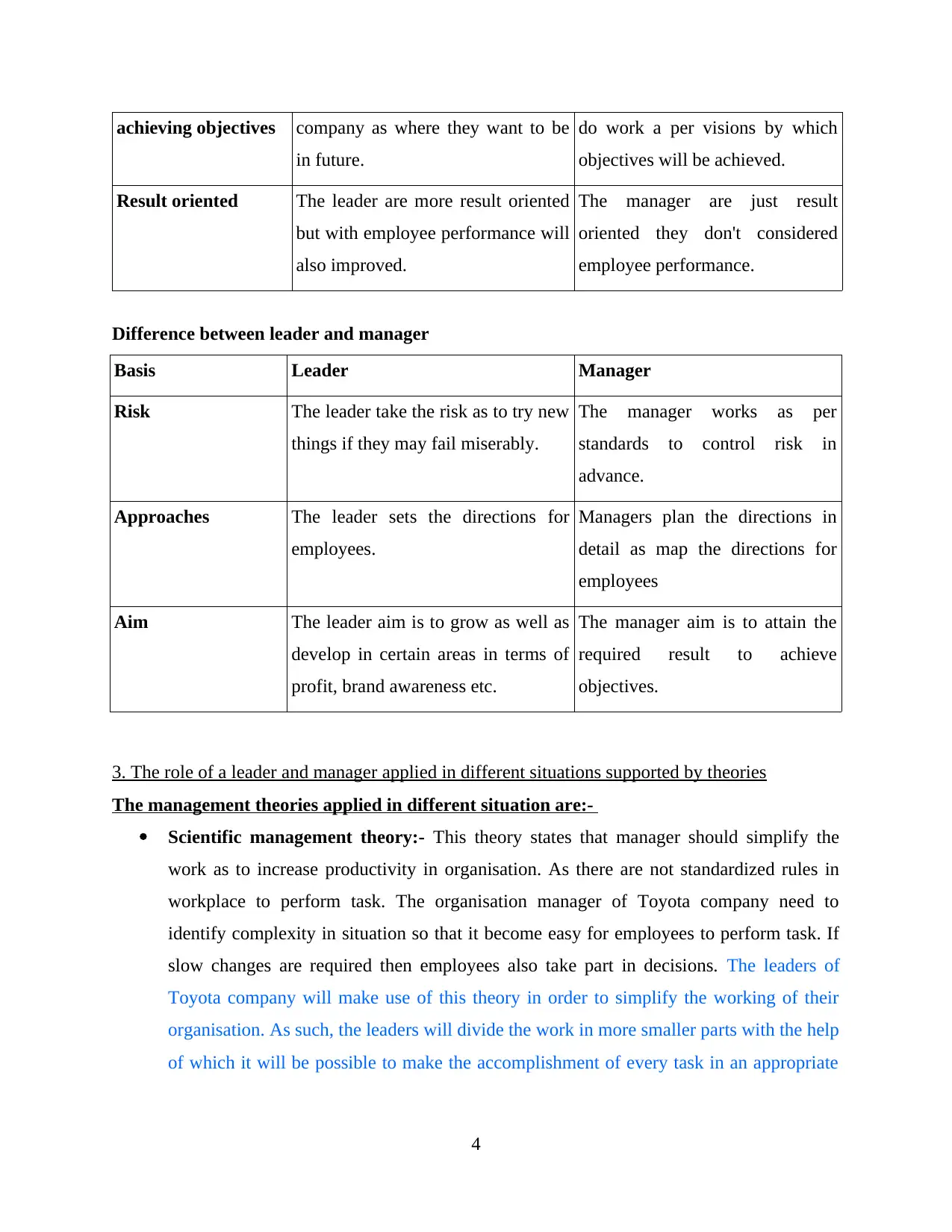
achieving objectives company as where they want to be
in future.
do work a per visions by which
objectives will be achieved.
Result oriented The leader are more result oriented
but with employee performance will
also improved.
The manager are just result
oriented they don't considered
employee performance.
Difference between leader and manager
Basis Leader Manager
Risk The leader take the risk as to try new
things if they may fail miserably.
The manager works as per
standards to control risk in
advance.
Approaches The leader sets the directions for
employees.
Managers plan the directions in
detail as map the directions for
employees
Aim The leader aim is to grow as well as
develop in certain areas in terms of
profit, brand awareness etc.
The manager aim is to attain the
required result to achieve
objectives.
3. The role of a leader and manager applied in different situations supported by theories
The management theories applied in different situation are:-
Scientific management theory:- This theory states that manager should simplify the
work as to increase productivity in organisation. As there are not standardized rules in
workplace to perform task. The organisation manager of Toyota company need to
identify complexity in situation so that it become easy for employees to perform task. If
slow changes are required then employees also take part in decisions. The leaders of
Toyota company will make use of this theory in order to simplify the working of their
organisation. As such, the leaders will divide the work in more smaller parts with the help
of which it will be possible to make the accomplishment of every task in an appropriate
4
in future.
do work a per visions by which
objectives will be achieved.
Result oriented The leader are more result oriented
but with employee performance will
also improved.
The manager are just result
oriented they don't considered
employee performance.
Difference between leader and manager
Basis Leader Manager
Risk The leader take the risk as to try new
things if they may fail miserably.
The manager works as per
standards to control risk in
advance.
Approaches The leader sets the directions for
employees.
Managers plan the directions in
detail as map the directions for
employees
Aim The leader aim is to grow as well as
develop in certain areas in terms of
profit, brand awareness etc.
The manager aim is to attain the
required result to achieve
objectives.
3. The role of a leader and manager applied in different situations supported by theories
The management theories applied in different situation are:-
Scientific management theory:- This theory states that manager should simplify the
work as to increase productivity in organisation. As there are not standardized rules in
workplace to perform task. The organisation manager of Toyota company need to
identify complexity in situation so that it become easy for employees to perform task. If
slow changes are required then employees also take part in decisions. The leaders of
Toyota company will make use of this theory in order to simplify the working of their
organisation. As such, the leaders will divide the work in more smaller parts with the help
of which it will be possible to make the accomplishment of every task in an appropriate
4
⊘ This is a preview!⊘
Do you want full access?
Subscribe today to unlock all pages.

Trusted by 1+ million students worldwide
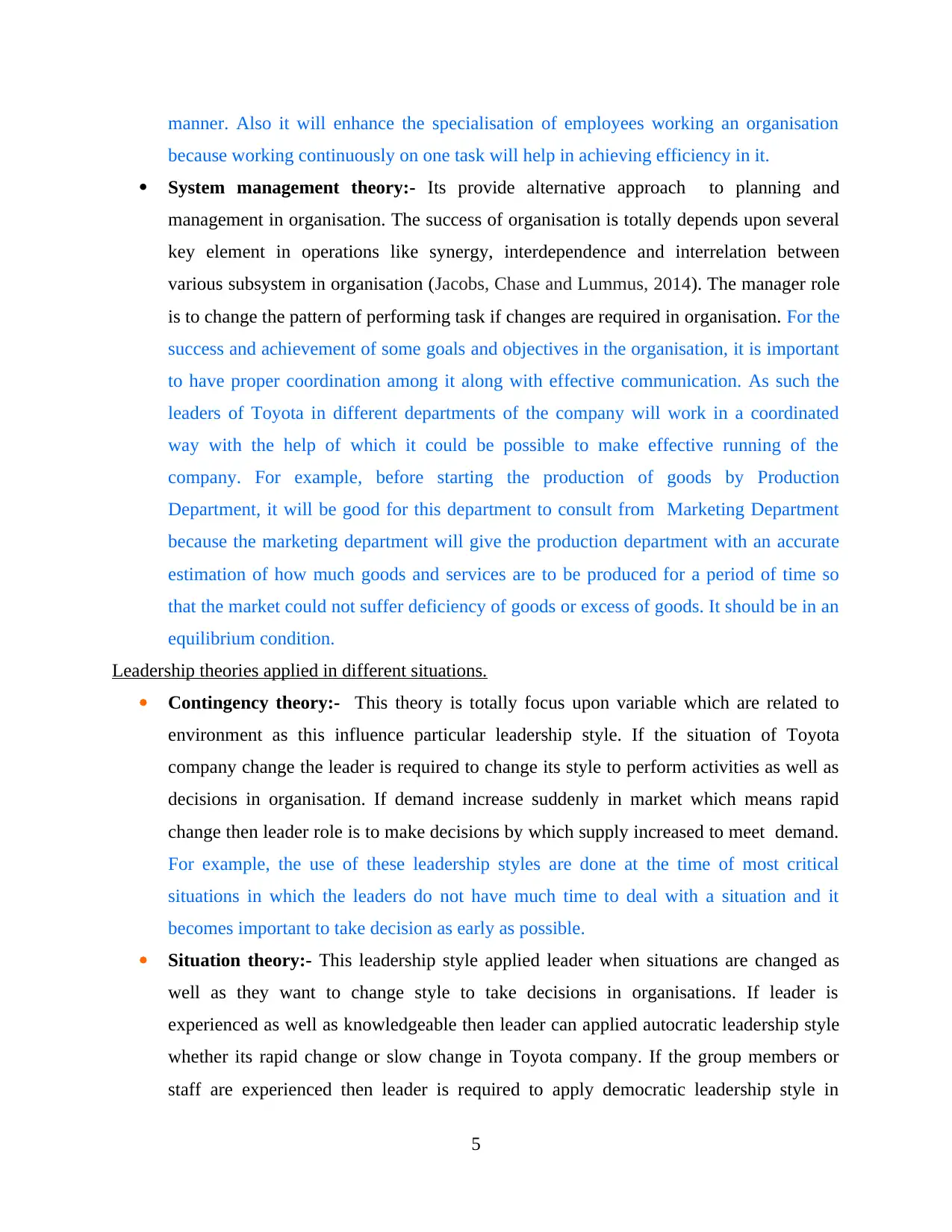
manner. Also it will enhance the specialisation of employees working an organisation
because working continuously on one task will help in achieving efficiency in it.
System management theory:- Its provide alternative approach to planning and
management in organisation. The success of organisation is totally depends upon several
key element in operations like synergy, interdependence and interrelation between
various subsystem in organisation (Jacobs, Chase and Lummus, 2014). The manager role
is to change the pattern of performing task if changes are required in organisation. For the
success and achievement of some goals and objectives in the organisation, it is important
to have proper coordination among it along with effective communication. As such the
leaders of Toyota in different departments of the company will work in a coordinated
way with the help of which it could be possible to make effective running of the
company. For example, before starting the production of goods by Production
Department, it will be good for this department to consult from Marketing Department
because the marketing department will give the production department with an accurate
estimation of how much goods and services are to be produced for a period of time so
that the market could not suffer deficiency of goods or excess of goods. It should be in an
equilibrium condition.
Leadership theories applied in different situations.
Contingency theory:- This theory is totally focus upon variable which are related to
environment as this influence particular leadership style. If the situation of Toyota
company change the leader is required to change its style to perform activities as well as
decisions in organisation. If demand increase suddenly in market which means rapid
change then leader role is to make decisions by which supply increased to meet demand.
For example, the use of these leadership styles are done at the time of most critical
situations in which the leaders do not have much time to deal with a situation and it
becomes important to take decision as early as possible.
Situation theory:- This leadership style applied leader when situations are changed as
well as they want to change style to take decisions in organisations. If leader is
experienced as well as knowledgeable then leader can applied autocratic leadership style
whether its rapid change or slow change in Toyota company. If the group members or
staff are experienced then leader is required to apply democratic leadership style in
5
because working continuously on one task will help in achieving efficiency in it.
System management theory:- Its provide alternative approach to planning and
management in organisation. The success of organisation is totally depends upon several
key element in operations like synergy, interdependence and interrelation between
various subsystem in organisation (Jacobs, Chase and Lummus, 2014). The manager role
is to change the pattern of performing task if changes are required in organisation. For the
success and achievement of some goals and objectives in the organisation, it is important
to have proper coordination among it along with effective communication. As such the
leaders of Toyota in different departments of the company will work in a coordinated
way with the help of which it could be possible to make effective running of the
company. For example, before starting the production of goods by Production
Department, it will be good for this department to consult from Marketing Department
because the marketing department will give the production department with an accurate
estimation of how much goods and services are to be produced for a period of time so
that the market could not suffer deficiency of goods or excess of goods. It should be in an
equilibrium condition.
Leadership theories applied in different situations.
Contingency theory:- This theory is totally focus upon variable which are related to
environment as this influence particular leadership style. If the situation of Toyota
company change the leader is required to change its style to perform activities as well as
decisions in organisation. If demand increase suddenly in market which means rapid
change then leader role is to make decisions by which supply increased to meet demand.
For example, the use of these leadership styles are done at the time of most critical
situations in which the leaders do not have much time to deal with a situation and it
becomes important to take decision as early as possible.
Situation theory:- This leadership style applied leader when situations are changed as
well as they want to change style to take decisions in organisations. If leader is
experienced as well as knowledgeable then leader can applied autocratic leadership style
whether its rapid change or slow change in Toyota company. If the group members or
staff are experienced then leader is required to apply democratic leadership style in
5
Paraphrase This Document
Need a fresh take? Get an instant paraphrase of this document with our AI Paraphraser
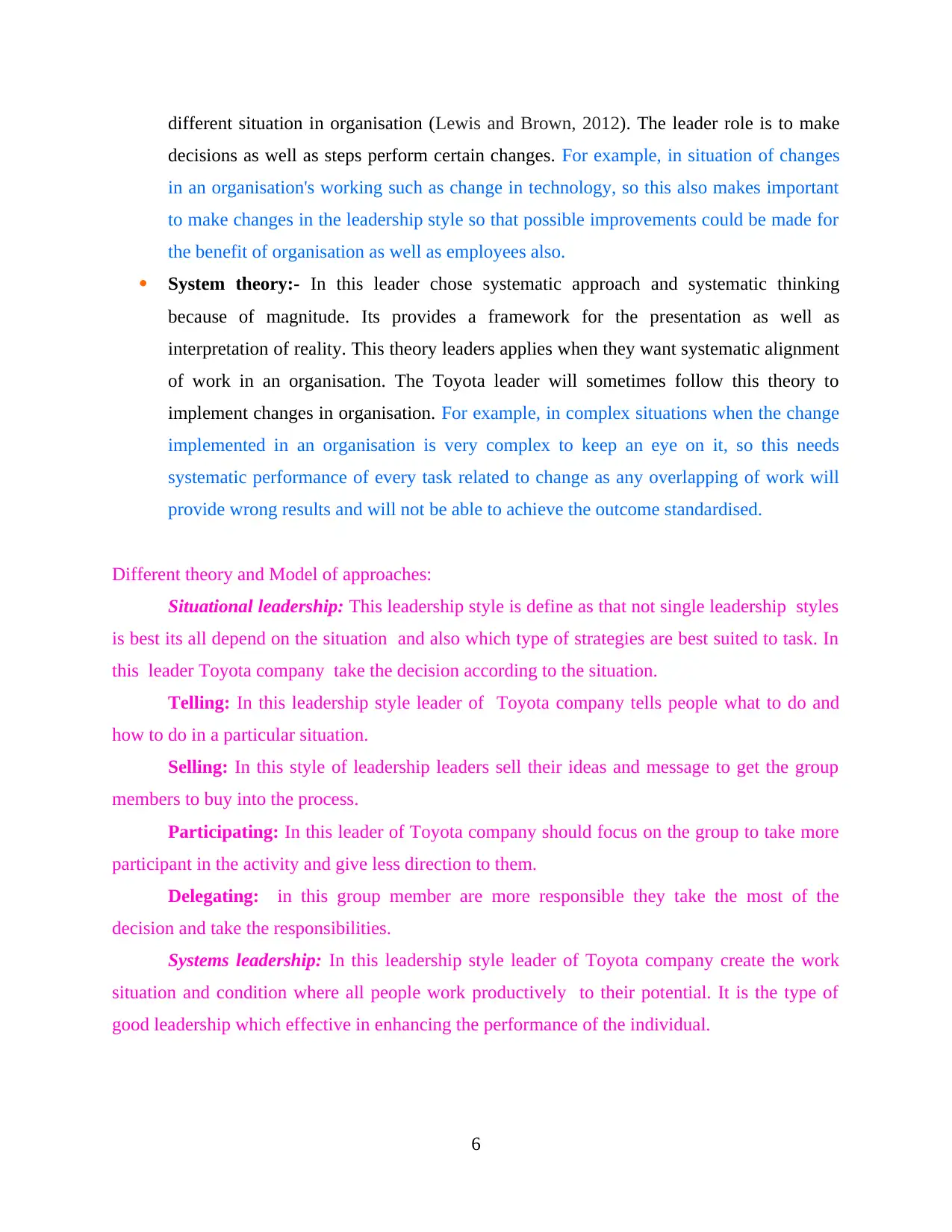
different situation in organisation (Lewis and Brown, 2012). The leader role is to make
decisions as well as steps perform certain changes. For example, in situation of changes
in an organisation's working such as change in technology, so this also makes important
to make changes in the leadership style so that possible improvements could be made for
the benefit of organisation as well as employees also.
System theory:- In this leader chose systematic approach and systematic thinking
because of magnitude. Its provides a framework for the presentation as well as
interpretation of reality. This theory leaders applies when they want systematic alignment
of work in an organisation. The Toyota leader will sometimes follow this theory to
implement changes in organisation. For example, in complex situations when the change
implemented in an organisation is very complex to keep an eye on it, so this needs
systematic performance of every task related to change as any overlapping of work will
provide wrong results and will not be able to achieve the outcome standardised.
Different theory and Model of approaches:
Situational leadership: This leadership style is define as that not single leadership styles
is best its all depend on the situation and also which type of strategies are best suited to task. In
this leader Toyota company take the decision according to the situation.
Telling: In this leadership style leader of Toyota company tells people what to do and
how to do in a particular situation.
Selling: In this style of leadership leaders sell their ideas and message to get the group
members to buy into the process.
Participating: In this leader of Toyota company should focus on the group to take more
participant in the activity and give less direction to them.
Delegating: in this group member are more responsible they take the most of the
decision and take the responsibilities.
Systems leadership: In this leadership style leader of Toyota company create the work
situation and condition where all people work productively to their potential. It is the type of
good leadership which effective in enhancing the performance of the individual.
6
decisions as well as steps perform certain changes. For example, in situation of changes
in an organisation's working such as change in technology, so this also makes important
to make changes in the leadership style so that possible improvements could be made for
the benefit of organisation as well as employees also.
System theory:- In this leader chose systematic approach and systematic thinking
because of magnitude. Its provides a framework for the presentation as well as
interpretation of reality. This theory leaders applies when they want systematic alignment
of work in an organisation. The Toyota leader will sometimes follow this theory to
implement changes in organisation. For example, in complex situations when the change
implemented in an organisation is very complex to keep an eye on it, so this needs
systematic performance of every task related to change as any overlapping of work will
provide wrong results and will not be able to achieve the outcome standardised.
Different theory and Model of approaches:
Situational leadership: This leadership style is define as that not single leadership styles
is best its all depend on the situation and also which type of strategies are best suited to task. In
this leader Toyota company take the decision according to the situation.
Telling: In this leadership style leader of Toyota company tells people what to do and
how to do in a particular situation.
Selling: In this style of leadership leaders sell their ideas and message to get the group
members to buy into the process.
Participating: In this leader of Toyota company should focus on the group to take more
participant in the activity and give less direction to them.
Delegating: in this group member are more responsible they take the most of the
decision and take the responsibilities.
Systems leadership: In this leadership style leader of Toyota company create the work
situation and condition where all people work productively to their potential. It is the type of
good leadership which effective in enhancing the performance of the individual.
6
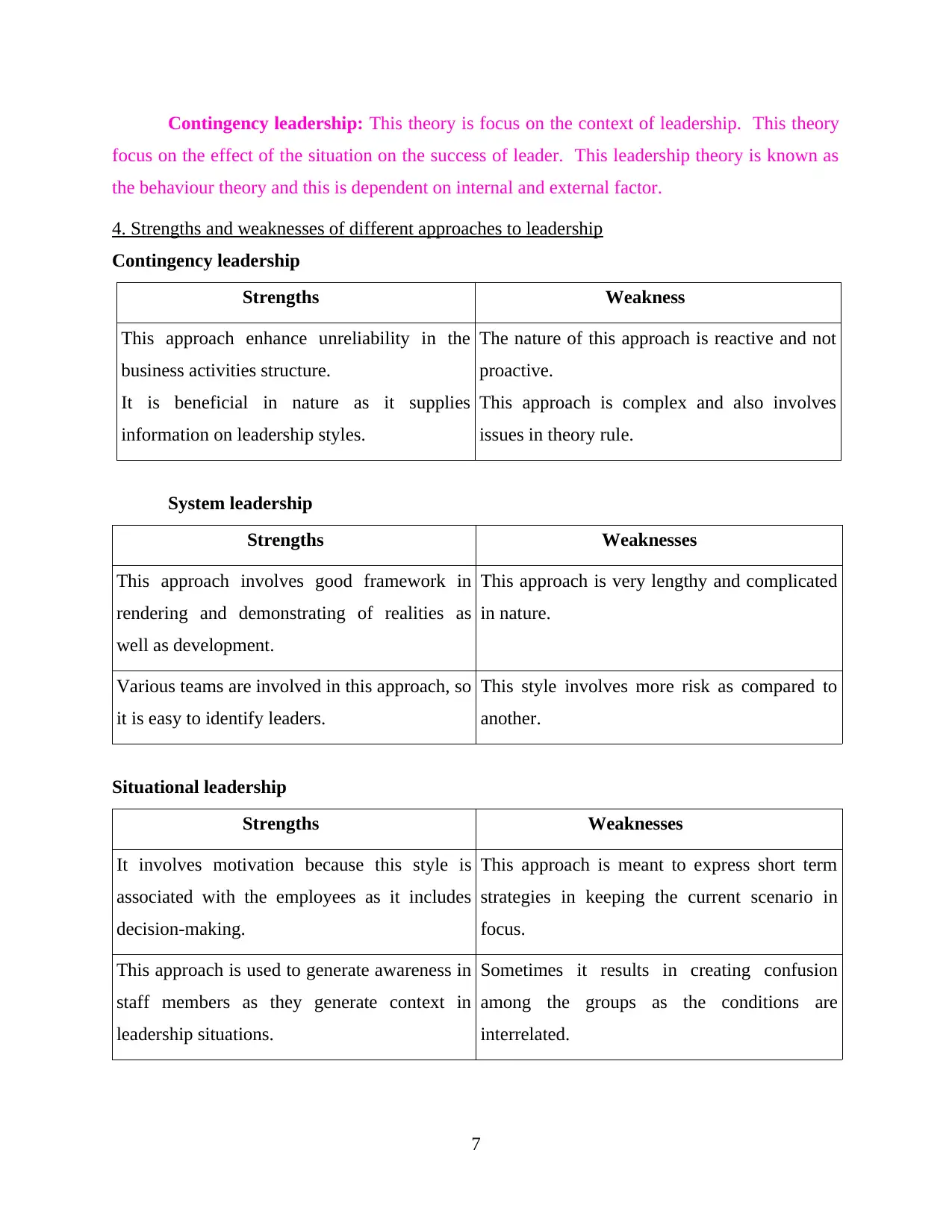
Contingency leadership: This theory is focus on the context of leadership. This theory
focus on the effect of the situation on the success of leader. This leadership theory is known as
the behaviour theory and this is dependent on internal and external factor.
4. Strengths and weaknesses of different approaches to leadership
Contingency leadership
Strengths Weakness
This approach enhance unreliability in the
business activities structure.
It is beneficial in nature as it supplies
information on leadership styles.
The nature of this approach is reactive and not
proactive.
This approach is complex and also involves
issues in theory rule.
System leadership
Strengths Weaknesses
This approach involves good framework in
rendering and demonstrating of realities as
well as development.
This approach is very lengthy and complicated
in nature.
Various teams are involved in this approach, so
it is easy to identify leaders.
This style involves more risk as compared to
another.
Situational leadership
Strengths Weaknesses
It involves motivation because this style is
associated with the employees as it includes
decision-making.
This approach is meant to express short term
strategies in keeping the current scenario in
focus.
This approach is used to generate awareness in
staff members as they generate context in
leadership situations.
Sometimes it results in creating confusion
among the groups as the conditions are
interrelated.
7
focus on the effect of the situation on the success of leader. This leadership theory is known as
the behaviour theory and this is dependent on internal and external factor.
4. Strengths and weaknesses of different approaches to leadership
Contingency leadership
Strengths Weakness
This approach enhance unreliability in the
business activities structure.
It is beneficial in nature as it supplies
information on leadership styles.
The nature of this approach is reactive and not
proactive.
This approach is complex and also involves
issues in theory rule.
System leadership
Strengths Weaknesses
This approach involves good framework in
rendering and demonstrating of realities as
well as development.
This approach is very lengthy and complicated
in nature.
Various teams are involved in this approach, so
it is easy to identify leaders.
This style involves more risk as compared to
another.
Situational leadership
Strengths Weaknesses
It involves motivation because this style is
associated with the employees as it includes
decision-making.
This approach is meant to express short term
strategies in keeping the current scenario in
focus.
This approach is used to generate awareness in
staff members as they generate context in
leadership situations.
Sometimes it results in creating confusion
among the groups as the conditions are
interrelated.
7
⊘ This is a preview!⊘
Do you want full access?
Subscribe today to unlock all pages.

Trusted by 1+ million students worldwide
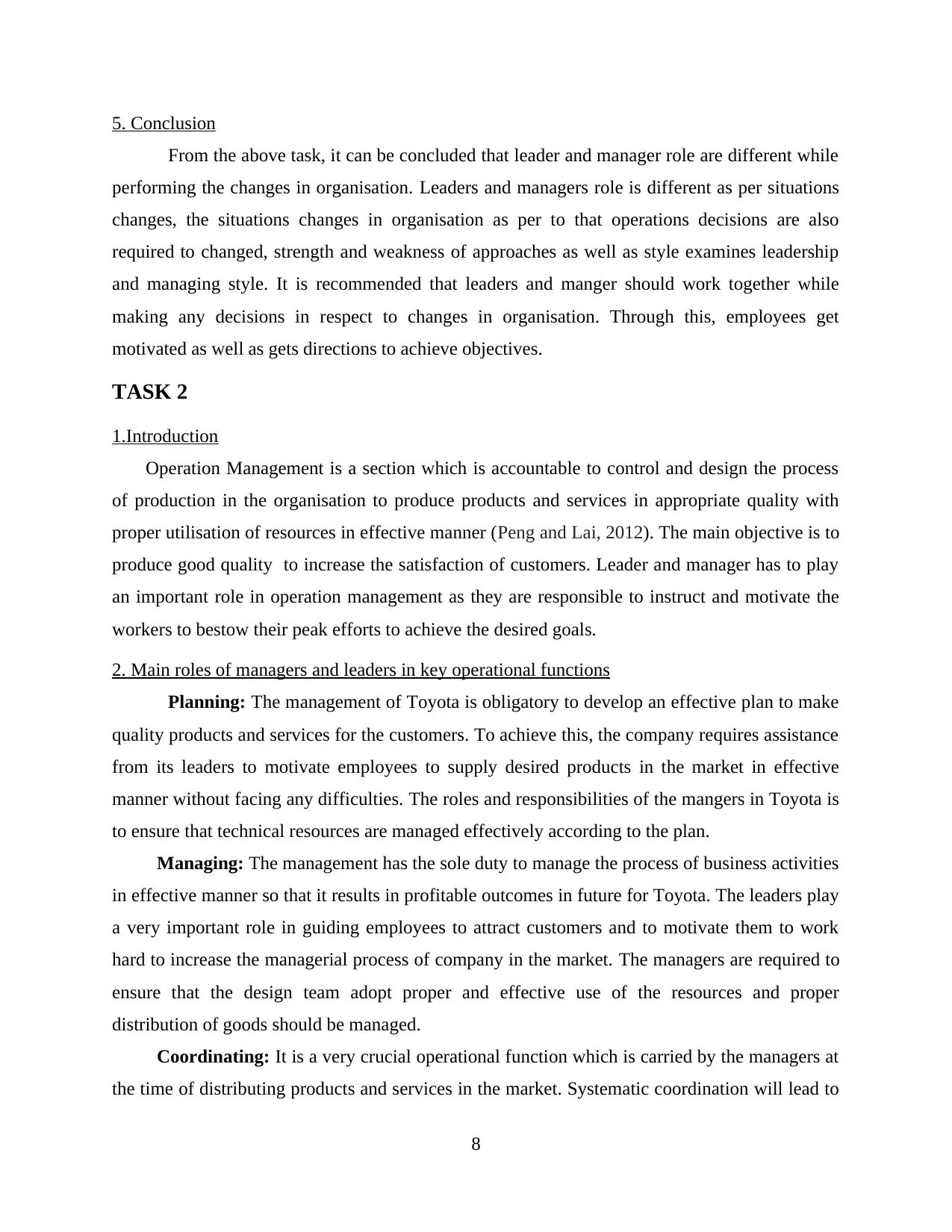
5. Conclusion
From the above task, it can be concluded that leader and manager role are different while
performing the changes in organisation. Leaders and managers role is different as per situations
changes, the situations changes in organisation as per to that operations decisions are also
required to changed, strength and weakness of approaches as well as style examines leadership
and managing style. It is recommended that leaders and manger should work together while
making any decisions in respect to changes in organisation. Through this, employees get
motivated as well as gets directions to achieve objectives.
TASK 2
1.Introduction
Operation Management is a section which is accountable to control and design the process
of production in the organisation to produce products and services in appropriate quality with
proper utilisation of resources in effective manner (Peng and Lai, 2012). The main objective is to
produce good quality to increase the satisfaction of customers. Leader and manager has to play
an important role in operation management as they are responsible to instruct and motivate the
workers to bestow their peak efforts to achieve the desired goals.
2. Main roles of managers and leaders in key operational functions
Planning: The management of Toyota is obligatory to develop an effective plan to make
quality products and services for the customers. To achieve this, the company requires assistance
from its leaders to motivate employees to supply desired products in the market in effective
manner without facing any difficulties. The roles and responsibilities of the mangers in Toyota is
to ensure that technical resources are managed effectively according to the plan.
Managing: The management has the sole duty to manage the process of business activities
in effective manner so that it results in profitable outcomes in future for Toyota. The leaders play
a very important role in guiding employees to attract customers and to motivate them to work
hard to increase the managerial process of company in the market. The managers are required to
ensure that the design team adopt proper and effective use of the resources and proper
distribution of goods should be managed.
Coordinating: It is a very crucial operational function which is carried by the managers at
the time of distributing products and services in the market. Systematic coordination will lead to
8
From the above task, it can be concluded that leader and manager role are different while
performing the changes in organisation. Leaders and managers role is different as per situations
changes, the situations changes in organisation as per to that operations decisions are also
required to changed, strength and weakness of approaches as well as style examines leadership
and managing style. It is recommended that leaders and manger should work together while
making any decisions in respect to changes in organisation. Through this, employees get
motivated as well as gets directions to achieve objectives.
TASK 2
1.Introduction
Operation Management is a section which is accountable to control and design the process
of production in the organisation to produce products and services in appropriate quality with
proper utilisation of resources in effective manner (Peng and Lai, 2012). The main objective is to
produce good quality to increase the satisfaction of customers. Leader and manager has to play
an important role in operation management as they are responsible to instruct and motivate the
workers to bestow their peak efforts to achieve the desired goals.
2. Main roles of managers and leaders in key operational functions
Planning: The management of Toyota is obligatory to develop an effective plan to make
quality products and services for the customers. To achieve this, the company requires assistance
from its leaders to motivate employees to supply desired products in the market in effective
manner without facing any difficulties. The roles and responsibilities of the mangers in Toyota is
to ensure that technical resources are managed effectively according to the plan.
Managing: The management has the sole duty to manage the process of business activities
in effective manner so that it results in profitable outcomes in future for Toyota. The leaders play
a very important role in guiding employees to attract customers and to motivate them to work
hard to increase the managerial process of company in the market. The managers are required to
ensure that the design team adopt proper and effective use of the resources and proper
distribution of goods should be managed.
Coordinating: It is a very crucial operational function which is carried by the managers at
the time of distributing products and services in the market. Systematic coordination will lead to
8
Paraphrase This Document
Need a fresh take? Get an instant paraphrase of this document with our AI Paraphraser
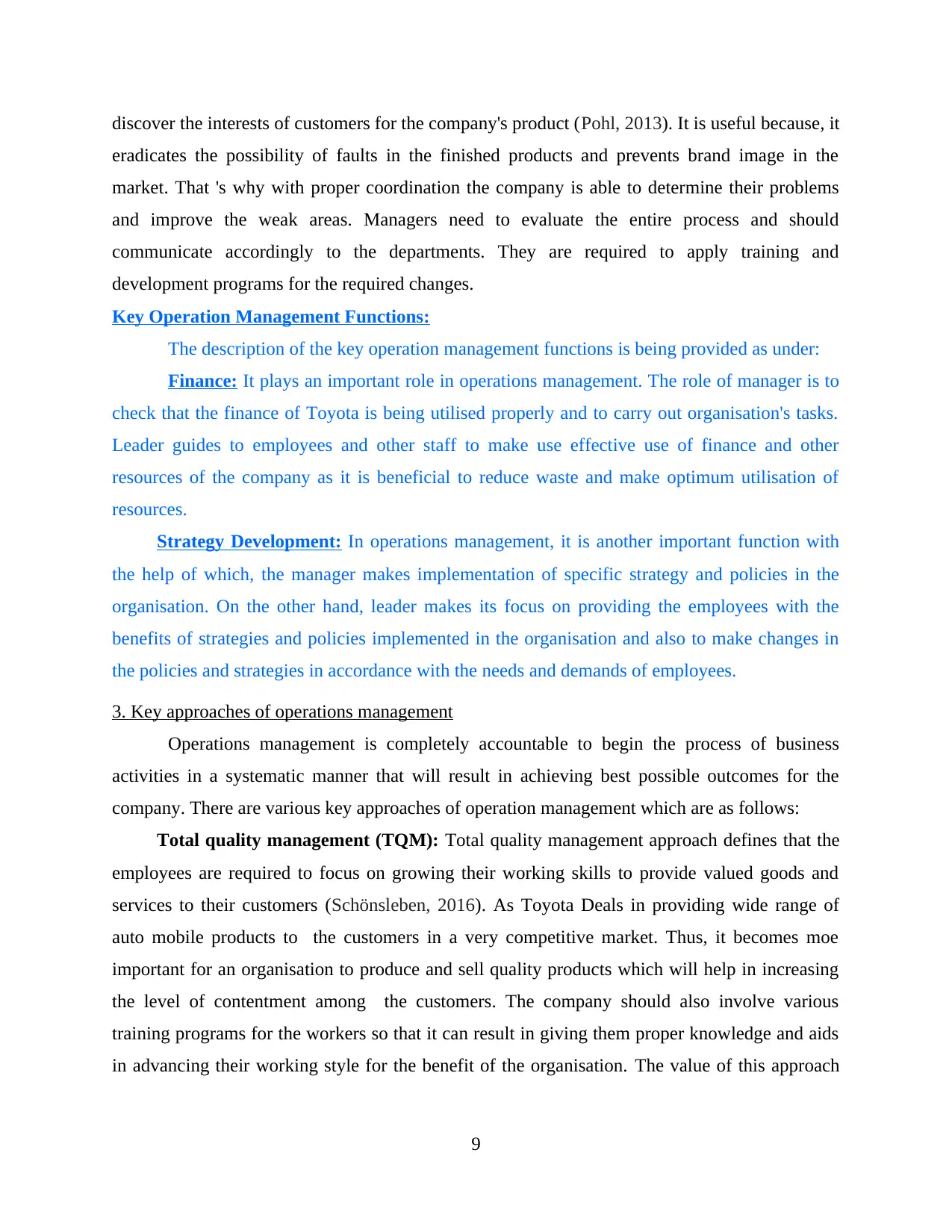
discover the interests of customers for the company's product (Pohl, 2013). It is useful because, it
eradicates the possibility of faults in the finished products and prevents brand image in the
market. That 's why with proper coordination the company is able to determine their problems
and improve the weak areas. Managers need to evaluate the entire process and should
communicate accordingly to the departments. They are required to apply training and
development programs for the required changes.
Key Operation Management Functions:
The description of the key operation management functions is being provided as under:
Finance: It plays an important role in operations management. The role of manager is to
check that the finance of Toyota is being utilised properly and to carry out organisation's tasks.
Leader guides to employees and other staff to make use effective use of finance and other
resources of the company as it is beneficial to reduce waste and make optimum utilisation of
resources.
Strategy Development: In operations management, it is another important function with
the help of which, the manager makes implementation of specific strategy and policies in the
organisation. On the other hand, leader makes its focus on providing the employees with the
benefits of strategies and policies implemented in the organisation and also to make changes in
the policies and strategies in accordance with the needs and demands of employees.
3. Key approaches of operations management
Operations management is completely accountable to begin the process of business
activities in a systematic manner that will result in achieving best possible outcomes for the
company. There are various key approaches of operation management which are as follows:
Total quality management (TQM): Total quality management approach defines that the
employees are required to focus on growing their working skills to provide valued goods and
services to their customers (Schönsleben, 2016). As Toyota Deals in providing wide range of
auto mobile products to the customers in a very competitive market. Thus, it becomes moe
important for an organisation to produce and sell quality products which will help in increasing
the level of contentment among the customers. The company should also involve various
training programs for the workers so that it can result in giving them proper knowledge and aids
in advancing their working style for the benefit of the organisation. The value of this approach
9
eradicates the possibility of faults in the finished products and prevents brand image in the
market. That 's why with proper coordination the company is able to determine their problems
and improve the weak areas. Managers need to evaluate the entire process and should
communicate accordingly to the departments. They are required to apply training and
development programs for the required changes.
Key Operation Management Functions:
The description of the key operation management functions is being provided as under:
Finance: It plays an important role in operations management. The role of manager is to
check that the finance of Toyota is being utilised properly and to carry out organisation's tasks.
Leader guides to employees and other staff to make use effective use of finance and other
resources of the company as it is beneficial to reduce waste and make optimum utilisation of
resources.
Strategy Development: In operations management, it is another important function with
the help of which, the manager makes implementation of specific strategy and policies in the
organisation. On the other hand, leader makes its focus on providing the employees with the
benefits of strategies and policies implemented in the organisation and also to make changes in
the policies and strategies in accordance with the needs and demands of employees.
3. Key approaches of operations management
Operations management is completely accountable to begin the process of business
activities in a systematic manner that will result in achieving best possible outcomes for the
company. There are various key approaches of operation management which are as follows:
Total quality management (TQM): Total quality management approach defines that the
employees are required to focus on growing their working skills to provide valued goods and
services to their customers (Schönsleben, 2016). As Toyota Deals in providing wide range of
auto mobile products to the customers in a very competitive market. Thus, it becomes moe
important for an organisation to produce and sell quality products which will help in increasing
the level of contentment among the customers. The company should also involve various
training programs for the workers so that it can result in giving them proper knowledge and aids
in advancing their working style for the benefit of the organisation. The value of this approach
9
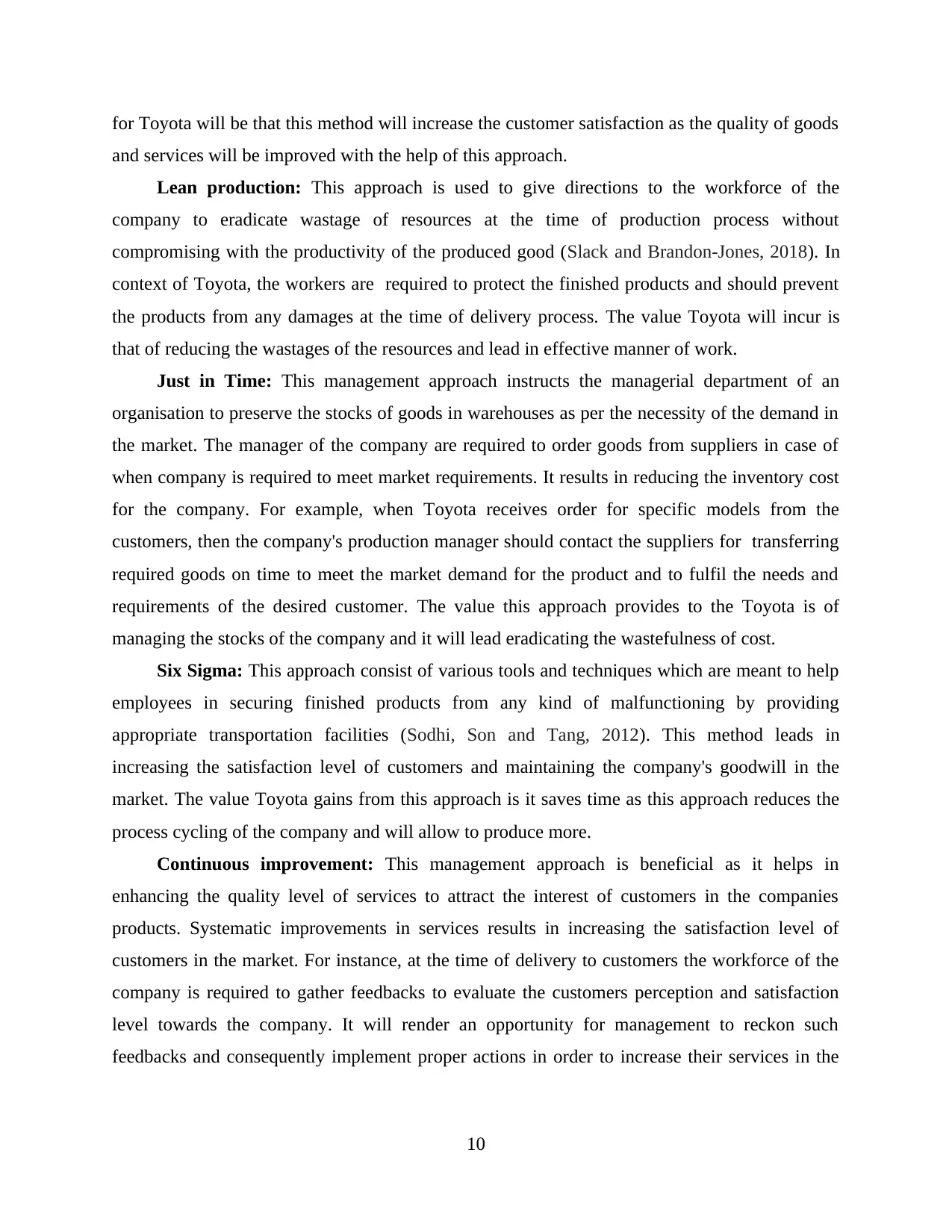
for Toyota will be that this method will increase the customer satisfaction as the quality of goods
and services will be improved with the help of this approach.
Lean production: This approach is used to give directions to the workforce of the
company to eradicate wastage of resources at the time of production process without
compromising with the productivity of the produced good (Slack and Brandon-Jones, 2018). In
context of Toyota, the workers are required to protect the finished products and should prevent
the products from any damages at the time of delivery process. The value Toyota will incur is
that of reducing the wastages of the resources and lead in effective manner of work.
Just in Time: This management approach instructs the managerial department of an
organisation to preserve the stocks of goods in warehouses as per the necessity of the demand in
the market. The manager of the company are required to order goods from suppliers in case of
when company is required to meet market requirements. It results in reducing the inventory cost
for the company. For example, when Toyota receives order for specific models from the
customers, then the company's production manager should contact the suppliers for transferring
required goods on time to meet the market demand for the product and to fulfil the needs and
requirements of the desired customer. The value this approach provides to the Toyota is of
managing the stocks of the company and it will lead eradicating the wastefulness of cost.
Six Sigma: This approach consist of various tools and techniques which are meant to help
employees in securing finished products from any kind of malfunctioning by providing
appropriate transportation facilities (Sodhi, Son and Tang, 2012). This method leads in
increasing the satisfaction level of customers and maintaining the company's goodwill in the
market. The value Toyota gains from this approach is it saves time as this approach reduces the
process cycling of the company and will allow to produce more.
Continuous improvement: This management approach is beneficial as it helps in
enhancing the quality level of services to attract the interest of customers in the companies
products. Systematic improvements in services results in increasing the satisfaction level of
customers in the market. For instance, at the time of delivery to customers the workforce of the
company is required to gather feedbacks to evaluate the customers perception and satisfaction
level towards the company. It will render an opportunity for management to reckon such
feedbacks and consequently implement proper actions in order to increase their services in the
10
and services will be improved with the help of this approach.
Lean production: This approach is used to give directions to the workforce of the
company to eradicate wastage of resources at the time of production process without
compromising with the productivity of the produced good (Slack and Brandon-Jones, 2018). In
context of Toyota, the workers are required to protect the finished products and should prevent
the products from any damages at the time of delivery process. The value Toyota will incur is
that of reducing the wastages of the resources and lead in effective manner of work.
Just in Time: This management approach instructs the managerial department of an
organisation to preserve the stocks of goods in warehouses as per the necessity of the demand in
the market. The manager of the company are required to order goods from suppliers in case of
when company is required to meet market requirements. It results in reducing the inventory cost
for the company. For example, when Toyota receives order for specific models from the
customers, then the company's production manager should contact the suppliers for transferring
required goods on time to meet the market demand for the product and to fulfil the needs and
requirements of the desired customer. The value this approach provides to the Toyota is of
managing the stocks of the company and it will lead eradicating the wastefulness of cost.
Six Sigma: This approach consist of various tools and techniques which are meant to help
employees in securing finished products from any kind of malfunctioning by providing
appropriate transportation facilities (Sodhi, Son and Tang, 2012). This method leads in
increasing the satisfaction level of customers and maintaining the company's goodwill in the
market. The value Toyota gains from this approach is it saves time as this approach reduces the
process cycling of the company and will allow to produce more.
Continuous improvement: This management approach is beneficial as it helps in
enhancing the quality level of services to attract the interest of customers in the companies
products. Systematic improvements in services results in increasing the satisfaction level of
customers in the market. For instance, at the time of delivery to customers the workforce of the
company is required to gather feedbacks to evaluate the customers perception and satisfaction
level towards the company. It will render an opportunity for management to reckon such
feedbacks and consequently implement proper actions in order to increase their services in the
10
⊘ This is a preview!⊘
Do you want full access?
Subscribe today to unlock all pages.

Trusted by 1+ million students worldwide
1 out of 17
Related Documents
Your All-in-One AI-Powered Toolkit for Academic Success.
+13062052269
info@desklib.com
Available 24*7 on WhatsApp / Email
![[object Object]](/_next/static/media/star-bottom.7253800d.svg)
Unlock your academic potential
Copyright © 2020–2025 A2Z Services. All Rights Reserved. Developed and managed by ZUCOL.





